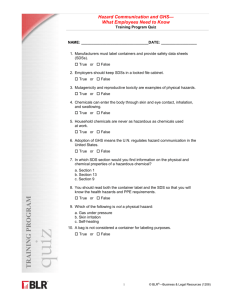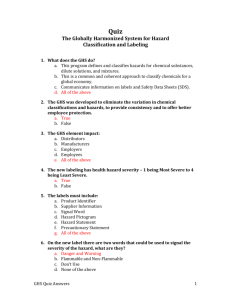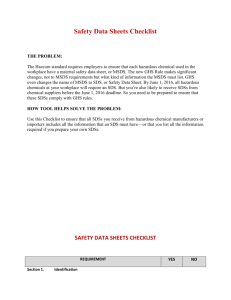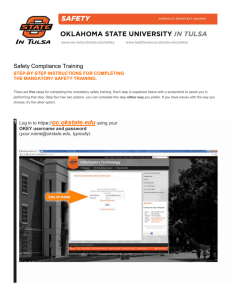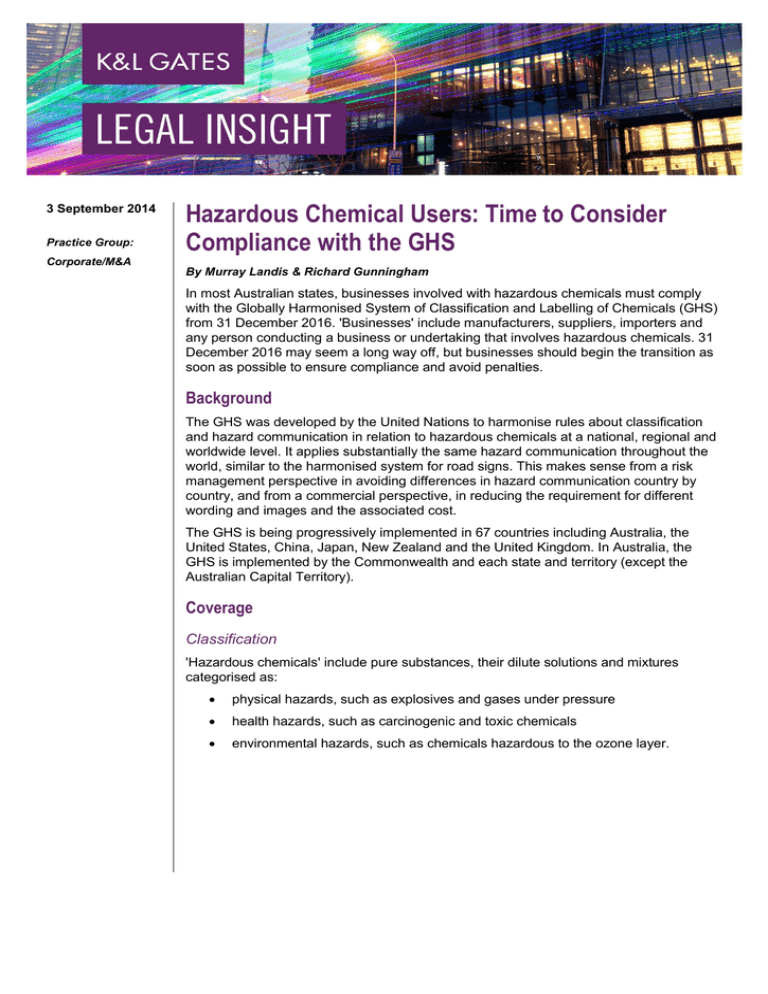
3 September 2014
Practice Group:
Hazardous Chemical Users: Time to Consider
Compliance with the GHS
Corporate/M&A
By Murray Landis & Richard Gunningham
In most Australian states, businesses involved with hazardous chemicals must comply
with the Globally Harmonised System of Classification and Labelling of Chemicals (GHS)
from 31 December 2016. 'Businesses' include manufacturers, suppliers, importers and
any person conducting a business or undertaking that involves hazardous chemicals. 31
December 2016 may seem a long way off, but businesses should begin the transition as
soon as possible to ensure compliance and avoid penalties.
Background
The GHS was developed by the United Nations to harmonise rules about classification
and hazard communication in relation to hazardous chemicals at a national, regional and
worldwide level. It applies substantially the same hazard communication throughout the
world, similar to the harmonised system for road signs. This makes sense from a risk
management perspective in avoiding differences in hazard communication country by
country, and from a commercial perspective, in reducing the requirement for different
wording and images and the associated cost.
The GHS is being progressively implemented in 67 countries including Australia, the
United States, China, Japan, New Zealand and the United Kingdom. In Australia, the
GHS is implemented by the Commonwealth and each state and territory (except the
Australian Capital Territory).
Coverage
Classification
'Hazardous chemicals' include pure substances, their dilute solutions and mixtures
categorised as:
physical hazards, such as explosives and gases under pressure
health hazards, such as carcinogenic and toxic chemicals
environmental hazards, such as chemicals hazardous to the ozone layer.
Hazardous Chemical Users: Time to Consider Compliance With the GHS
Hazard Communication
Labels for hazardous chemicals must contain:
the relevant symbol for the hazard, imposed onto a pictogram
a signal word such as 'danger' or 'warning'
a hazard statement that describes the nature of the hazard, for example 'may
cause cancer if inhaled'
a precautionary statement that describes the recommended measures to
minimise the hazard risk.
The specific symbol and wording depends on the chemical classification. The GHS also
sets out 16 minimum elements for Safety Data Sheets (SDS).
Compliance with the GHS Alone: Is it Enough?
In Australia, the short answer is 'no'. Most Australian jurisdictions impose additional
requirements to the GHS.
Labelling
The additional requirements include that:
the label must identify the ingredient that causes the hazardous chemical to fall
within certain listed hazard classes, and the proportion of that ingredient to the
rest of the chemical
the label must contain any information about the hazard, first aid and emergency
procedures not included in the wording required by the GHS.
Packaging
The GHS does not contain any requirements for packing hazardous chemicals. Most
Australian jurisdictions require that:
the hazardous chemical must be packed in a container (in sound condition)
the container must be made of material compatible with the hazardous chemical.
Classification and SDS
Most Australian jurisdictions have adopted a modified version of the GHS classification
regime and contain additional requirements for an SDS.
2
Hazardous Chemical Users: Time to Consider Compliance With the GHS
Action Steps
We recommend that businesses conduct a GHS review of their labelling and packaging
for hazardous chemicals. If there is any doubt about complying with the GHS, it is best to
get advice early rather than face possible prosecution as well as adverse publicity and
penalties.
Authors:
Murray Landis
murray.landis@klgates.com
+61.7.3233.1231
Richard Gunningham
richard.gunningham@klgates.com
+61.7.3233.1237
Anchorage Austin Beijing Berlin Boston Brisbane Brussels Charleston Charlotte Chicago Dallas Doha Dubai Fort Worth Frankfurt
Harrisburg Hong Kong Houston London Los Angeles Melbourne Miami Milan Moscow Newark New York Orange County Palo Alto
Paris Perth Pittsburgh Portland Raleigh Research Triangle Park San Francisco São Paulo Seattle Seoul Shanghai Singapore
Spokane Sydney Taipei Tokyo Warsaw Washington, D.C. Wilmington
K&L Gates comprises more than 2,000 lawyers globally who practice in fully integrated offices located on five
continents. The firm represents leading multinational corporations, growth and middle-market companies,
capital markets participants and entrepreneurs in every major industry group as well as public sector entities,
educational institutions, philanthropic organizations and individuals. For more information about K&L Gates or
its locations, practices and registrations, visit www.klgates.com.
This publication is for informational purposes and does not contain or convey legal advice. The information herein should not be used or relied upon
in regard to any particular facts or circumstances without first consulting a lawyer.
© 2014 K&L Gates LLP. All Rights Reserved.
3

